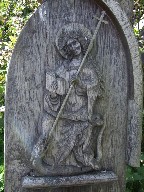| |
|
In a brief
flirtation with lunacy in the 1970s, the Diocese
sold off this and several other churches to the
highest bidders. Perhaps the parish had lost
confidence in itself, or perhaps it was a
well-meaning, if short-sighted, attempt to
rationalise resources. I use the word 'lunacy'
advisedly, for there are two reasons why some
churches should never be sold off for private
use, and they both apply here. Firstly, this was
a significant historic building, which would
certainly find itself in the care of the Churches
Conservation Trust if it was abandoned today. It
had a scattering of medieval glass, a brass (now
at Thorndon), and a significant 17th
century memorial. The gorgeous font is now at Mendlesham, as are the benches.
Secondly, a medieval parish church is at the
heart of an English country village. Maybe it did
not seem that way back in the 1970s, when
villages as small as Rishangles might still have
a shop, a post office, and even a school, and
something of a community life. But these have now
gone, all over England, and the parish church is
the one survivor, except in places like
Rishangles. St
Margaret was not alone; the nearby equally
significant and historic churches of Mickfield and Ubbeston met the same fate. When I
first came here in the 1990s it was to find St
Margaret a sad sight, rundown and neglected.
After its sale, this was a craft workshop for
several years, and in 1999 the sign for 'Old
Church Studios' survived, albeit lying decaying
on the verge. Although a large sign at the
entrance said private, there was no
gate, and I walked into the graveyard. This was
fairly neglected, but some graves had been cared
for very recently; perhaps there was a local sigh
of relief when the gate came down. The building
appeared in a bit of a state, but scaffolding
surrounded the tower, and the bell openings were
being replaced by what appeared to be French
windows, as if a penthouse apartment was being
installed up there. Thirty years ago, there were
four medieval bells. I wonder what happened to
them. A wire fence surrounded the building, the
usual paraphernalia of a building site scattered
around it. It was pouring with rain by now, and I
didn't have the heart to investigate much
further. To be honest, it was all a bit grim.
And grim reading
is the entry made for Rishangles parish church at
the time of the 1851 Census of Religious Worship.
Out of a parish population of 279, a mere 22 had
attended the morning service, barely one in
thirteen, and one of the lowest attendances in
Suffolk. This was a strongly non-conformist
village, and the Baptist church directly across
road played host to 180 people that morning, and
almost 220 in the afternoon. The Reverend Hyam
Burn, the recently appointed Rector of St
Margaret, must have wondered what he had taken
on. He moaned that many children are employed
on Sunday frequently in protecting seeds sown in
fields at usual seasons of the year,
although you can't help thinking that if this
were true of Rishangles it would have been
equally true of almost anywhere in Suffolk. He
pointed out that when he had been inducted in
1849 the church was then not so well attended
as now and there was no church Sunday School.
He complained that there were two Dissenting
places of worship in the parish filled chiefly by
out-parishioners, although again, if this
were true you can't help wondering where the
residents of Rishangles were going. A daily
school would be a great boon, he finished,
rather wistfully. However, contemporary observers
noted that there was a bitter animosity towards
the Church of England in Rishangles and its
neighbouring villages, and that very few and far
between were poorer families who were not active
dissenters. It sounds a fascinating story.
| Coming
back in 2011, it was with some
trepidation that I once again cycled up
the village street towards the gap in the
hedge; but the private sign had
gone, and so had the signs of neglect.
The graveyard seemed well-kept and
well-visited, and the church building
itself appeared in good shape, if a
little overgrown: a curious glass
structure to the north of the tower looks
like a spiral staircase, but I think is
just intended to let light in. The building has
been converted into holiday cottages,
with four bedrooms sleeping up to ten
people. There are a number of photographs
of the interior on the internet which
shows that it is well-kept inside, and
much of the original integrity survives,
which is good news.
Meanwhile,
across the road, the Baptist church
expanded its premises greatly in the
1980s, with a fine modern extension to
the 19th century chapel. It is rightly
thriving, directly in the face of its
moribund medieval predecessor. The
Reverend Hyam Burn's pessimism was
well-founded.
|
|
 |
|
|
|

